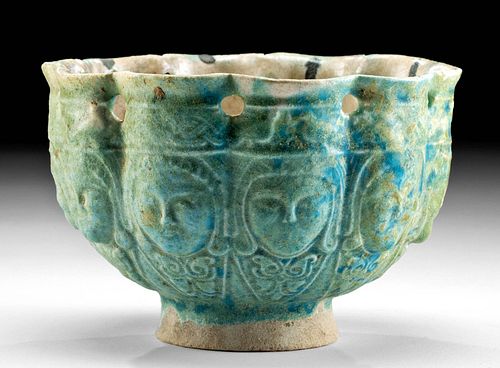12th C. Persian Seljuk Pottery Bowl w/ Faces, TL Tested
Lot 107
About Seller
Artemis Gallery
686 S Taylor Ave, Ste 106
Louisville, CO 80027
United States
Selling antiquities, ancient and ethnographic art online since 1993, Artemis Gallery specializes in Classical Antiquities (Egyptian, Greek, Roman, Near Eastern), Asian, Pre-Columbian, African / Tribal / Oceanographic art. Our extensive inventory includes pottery, stone, metal, wood, glass and textil...Read more
Categories
Estimate:
$30,000 - $45,000
Absentee vs Live bid
Two ways to bid:
- Leave a max absentee bid and the platform will bid on your behalf up to your maximum bid during the live auction.
- Bid live during the auction and your bids will be submitted real-time to the auctioneer.
Bid Increments
| Price | Bid Increment |
|---|---|
| $0 | $25 |
| $300 | $50 |
| $1,000 | $100 |
| $2,000 | $250 |
| $5,000 | $500 |
| $10,000 | $1,000 |
| $20,000 | $2,500 |
| $50,000 | $5,000 |
| $100,000 | $10,000 |
| $200,000 | $20,000 |
About Auction
By Artemis Gallery
Oct 7, 2021
Set Reminder
2021-10-07 10:00:00
2021-10-07 10:00:00
America/New_York
Bidsquare
Bidsquare : Exceptional Antiquities Ethnographic Fine Art
https://www.bidsquare.com/auctions/artemis-gallery/exceptional-antiquities-ethnographic-fine-art-7537
Museum-worthy examples of Egyptian, Greek, Roman, Etruscan, Near Eastern, Far East / Asian, Pre-Columbian, African / Tribal, Oceanic, Native American, Spanish Colonial, Fossils, Ancient Jewelry, Fine / Visual Arts, so much more! Artemis Gallery info@artemisgallery.com
Museum-worthy examples of Egyptian, Greek, Roman, Etruscan, Near Eastern, Far East / Asian, Pre-Columbian, African / Tribal, Oceanic, Native American, Spanish Colonial, Fossils, Ancient Jewelry, Fine / Visual Arts, so much more! Artemis Gallery info@artemisgallery.com
- Lot Description
Near East, Persia (Iran and Turkey), Kashan or Nishapur, Seljuk Empire (Seljuq), ca. 12th century CE. A gorgeous pottery bowl with a scalloped rim and molded faces around the exterior glazed with a brilliant blue. The bowl rests on the ring base, and a remarkable detail is an interlacing linear pattern molded into the unglazed base. The scalloped walls rise to the deep basin, each lobe decorated with a relief visage of a woman with a heart shaped face, high cheekbones, and almond eyes; her hair or veil falling to her chin, and a scrolling foliate pattern below. Birds and a woven knot pattern alternate above the faces, all glazed a turquoise blue, with iridescence forming throughout! These women have been interpreted as harpies or Buraq, and they exhibit the classic style of Seljuk portraiture. The walls are perforated just below the rim, and black pigments are dotted around the lip and some glaze has dripped into the creamy white basin. This type of pottery is truly exceptional and is wonderfully preserved! Size: 5.5" Diameter x 3.75" H (14 cm x 9.5 cm)
Nishapur was a center of politics and culture in medieval Persia, and their pottery is some of the most unique and beautiful in history. These turquoise items are the result of technological innovation at the end of the 10th century. The body of this bowl and others of its style is made of finely ground quartz mixed with clay; this created a white surface on which the artists could paint designs directly. The glaze is alkaline, with a copper base to give it its color, and would be poured over the clay. Manganese was used to create the black rim stripes. These pieces may have been inspired by the blue and white glazed pottery that travelled the Silk Road from Tang Dynasty, China, but the end result here is clearly not just an imitation, but an entirely different, radical style developed in Nishapur.
For a similar example of this form with a cobalt glaze, please see the Harvard Museum, object number 2002.50.95.
This piece has been tested using thermoluminescence (TL) analysis and has been found to be ancient and of the period stated. A full report will accompany purchase.
This piece has been searched against the Art Loss Register database and has been cleared. The Art Loss Register maintains the world's largest database of stolen art, collectibles, and antiques.
Provenance: private Southern California, USA collection, in the USA since 1997
All items legal to buy/sell under U.S. Statute covering cultural patrimony Code 2600, CHAPTER 14, and are guaranteed to be as described or your money back.
A Certificate of Authenticity will accompany all winning bids.
PLEASE NOTE: Due to recent increases of shipments being seized by Australian & German customs (even for items with pre-UNESCO provenance), we will no longer ship most antiquities and ancient Chinese art to Australia & Germany. For categories of items that are acceptable to ship to Australia or Germany, please contact us directly or work with your local customs brokerage firm.
Display stands not described as included/custom in the item description are for photography purposes only and will not be included with the item upon shipping.
#167302Some glazing and firing imperfections, but intact and excellent. The interior basin has remains of a ring base, possibly from another piece during firing. Some fading to glaze and rainbow iridescence has formed on surfaces. Single TL hole on interior ring foot. Light earth deposits around base. Nice craquelure!Condition
- Shipping Info
-
All shipping is handled in-house for your convenience. Your invoice from Artemis Gallery will include shipping calculation instructions. If in doubt, please inquire BEFORE bidding for estimated shipping costs for individual items.
-
- Buyer's Premium



 EUR
EUR CAD
CAD AUD
AUD GBP
GBP MXN
MXN HKD
HKD CNY
CNY MYR
MYR SEK
SEK SGD
SGD CHF
CHF THB
THB
















